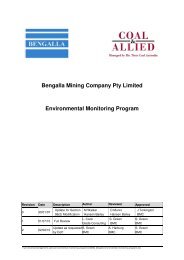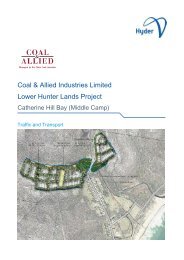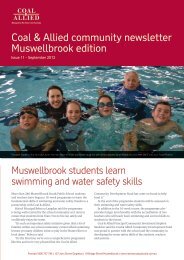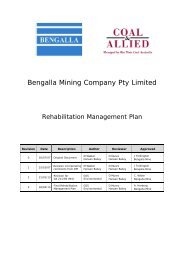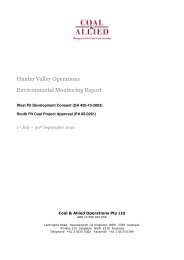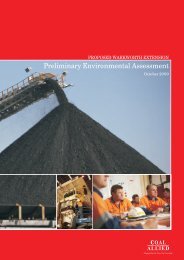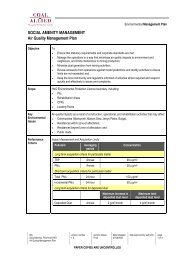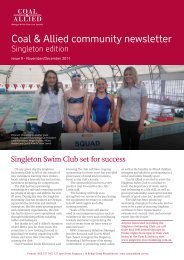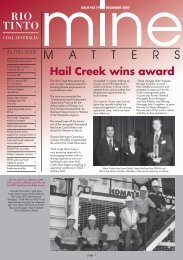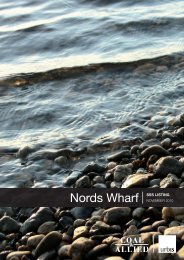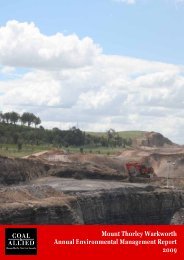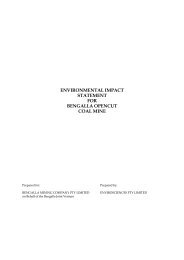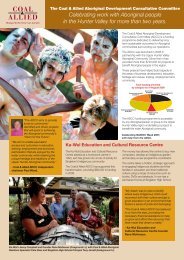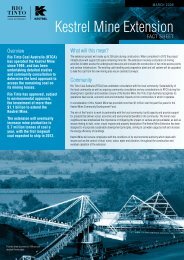HVO 2009 Annual Environmental Management Report - Final
HVO 2009 Annual Environmental Management Report - Final
HVO 2009 Annual Environmental Management Report - Final
You also want an ePaper? Increase the reach of your titles
YUMPU automatically turns print PDFs into web optimized ePapers that Google loves.
Coal & Allied – Hunter Valley Operations<br />
2.2.1 Vegetation Clearing<br />
All cleared timber suitable for re-use as milling timber, fencing material or habitat reinstatement is<br />
appropriately pushed up and cut as part of the timber removal and soil-stripping process. Prior to being used<br />
for mining the vast majority of the site is selectively logged for use as fencing products. Additional unusable<br />
timber is mulched for use on rehabilitation areas in order to retain moisture and nutrients and encourage seed<br />
growth. While other remaining vegetative material is cut to size and either stored or relocated to rehabilitation<br />
areas to provide habitat for fauna in accordance with Coal & Allied EMS <strong>Environmental</strong> Procedure 10.2 Fauna<br />
and Flora.<br />
Other remaining vegetative material which is unable to be used is cut to size and heaped, then pushed onto<br />
the blasted ground and buried in the truck spoil. Vegetation removal ahead of mining is typically kept to within<br />
two mining strips of the high wall, with provision for infrastructure and an access road located along the edge<br />
of the strip area.<br />
At <strong>HVO</strong>, native tree and shrub seed is harvested from areas within the mine lease and areas designated to be<br />
cleared. During <strong>2009</strong> a Seed Strategy was developed for <strong>HVO</strong> and MTW to enhance species diversity and<br />
creation of habitat on the areas of post-mining rehabilitation. There were two main components to developing<br />
the Strategy: Part 1 – Review of the species mix to align with pre-mining communities and improve diversity<br />
(particularly of understorey species); and Part 2 – Formalise the procedures for collecting and storing local<br />
provenance native seed. The strategy will assist CNA to improve future native vegetation seed collection and<br />
rehabilitation programmes.<br />
2.2.2 Topsoil <strong>Management</strong><br />
Topsoil stripping and vegetation salvage is carried out in accordance with the relevant <strong>HVO</strong> MOP and Coal &<br />
Allied EMS <strong>Environmental</strong> Procedure 5.1 Disturbance and Rehabilitation prior to the commencement of drill<br />
and blast preparation. The depth of useful soil is identified on the topsoil stripping plan on a site-specific<br />
basis, owing to the high variability in topsoil quality and depth. Topsoil is then used directly on new<br />
rehabilitation areas wherever possible or stockpiled for re-use at various strategic locations around the mine<br />
site and surveyed. The topsoil stockpiles and volumes are maintained by the Coal & Allied <strong>Environmental</strong><br />
Specialist Rehabilitation, as per the Coal & Allied EMS <strong>Environmental</strong> Procedure 5.1 Disturbance and<br />
Rehabilitation.<br />
2.3 CONSTRUCTION<br />
The only additions or alterations to buildings or facilities during the <strong>2009</strong> reporting period were modifications<br />
and additions to the Lemington Facilities.<br />
2.4 MINING<br />
<strong>HVO</strong> is organised into six mining zones; West, North, and Carrington Pits to the north of the Hunter River and<br />
Riverview, Cheshunt and Lemington South Pits to the south of the Hunter River. The area to be mined is<br />
geologically modelled, a plan is formed and the relevant mining locations are surveyed.<br />
The area immediately preceding the active mining zone is stripped of topsoil, which is stockpiled for future<br />
rehabilitation purposes or placed directly onto shaped areas where available.<br />
To improve efficiency, overburden removal above the first seam and each subsequent layer of interburden is<br />
drilled and blasted or ripped. Shovels, excavators and loaders remove the overburden/interburden, which is<br />
transported by truck to be placed in previously worked areas of the mine. In addition to truck transportation,<br />
draglines relocate large quantities of overburden/interburden within the pit. The top of each of the coal seams<br />
is cleaned and prepared, then blasted or ripped and finally loaded by front-end loaders into haulage trucks.<br />
Raw coal is transported to the Coal Preparation Plants (CPP) including the Hunter Valley CPP and Howick<br />
CPP. The Newdell CPP is currently used only as a loading facility, whilst operations at the Lemington CPP<br />
are currently suspended. The product coal is directly loaded at the Newdell or Hunter Valley Load Point<br />
(HVLP) and railed to the Port of Newcastle for export. The coarse reject coal from the washing process is<br />
trucked back into the active spoil emplacement areas for co-disposal with overburden.<br />
AEMR <strong>2009</strong> 29



